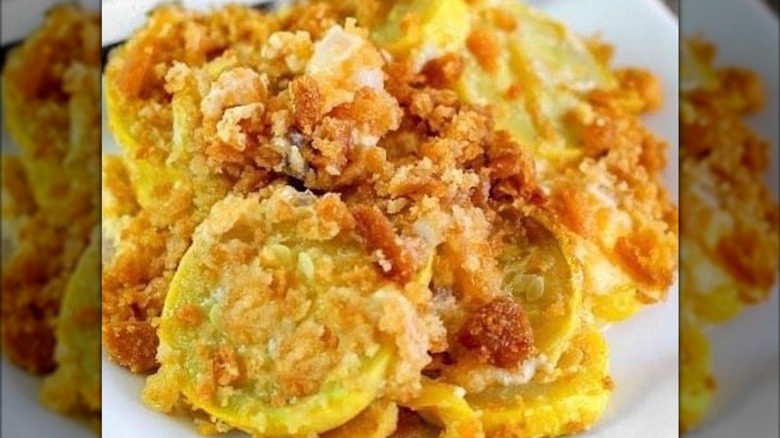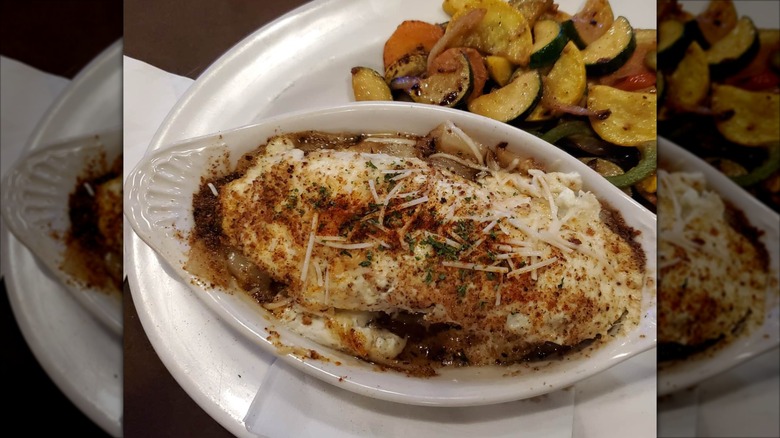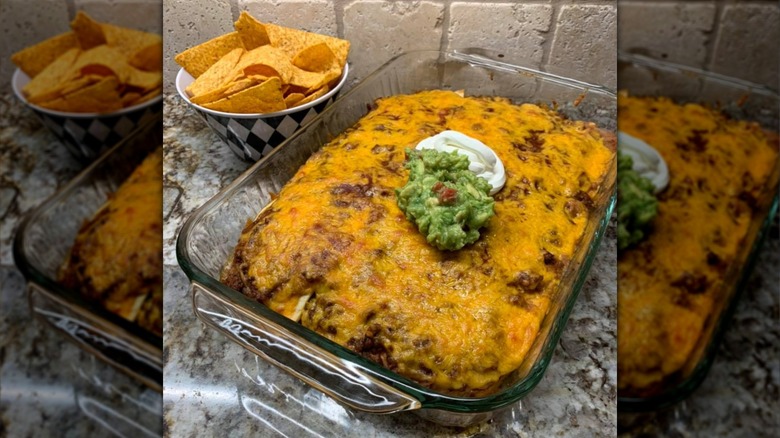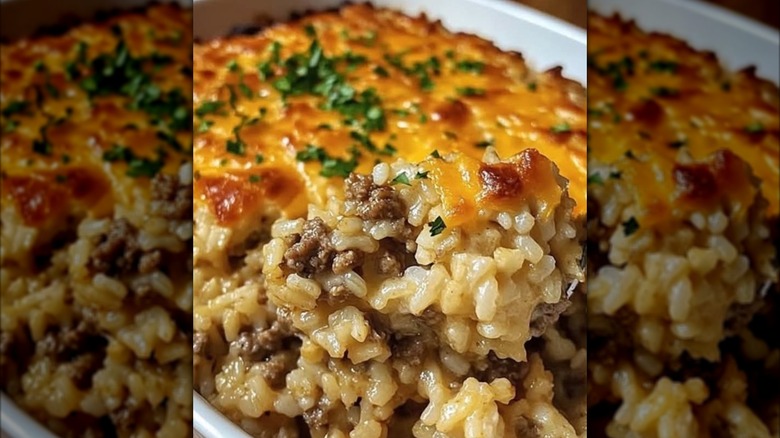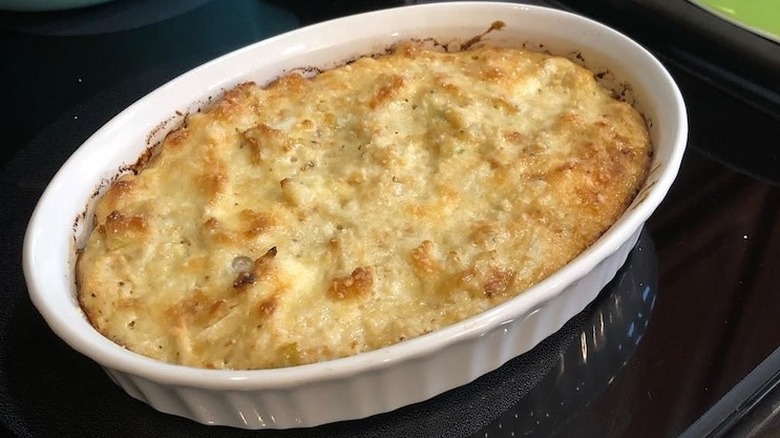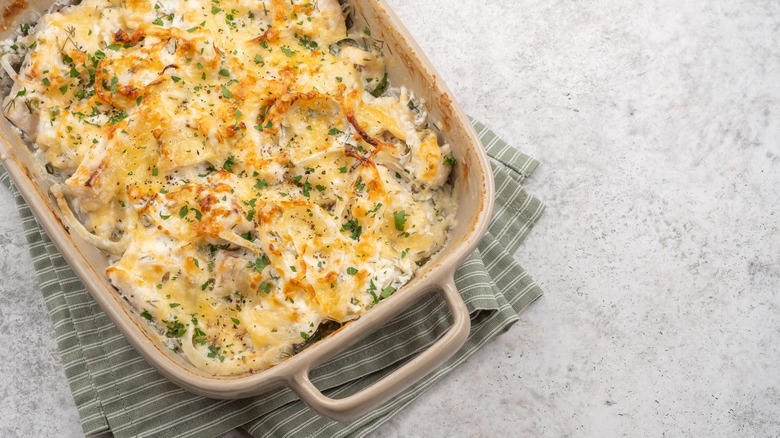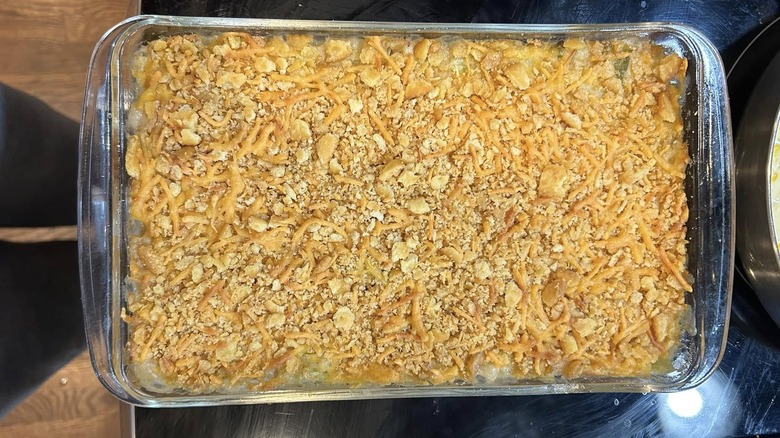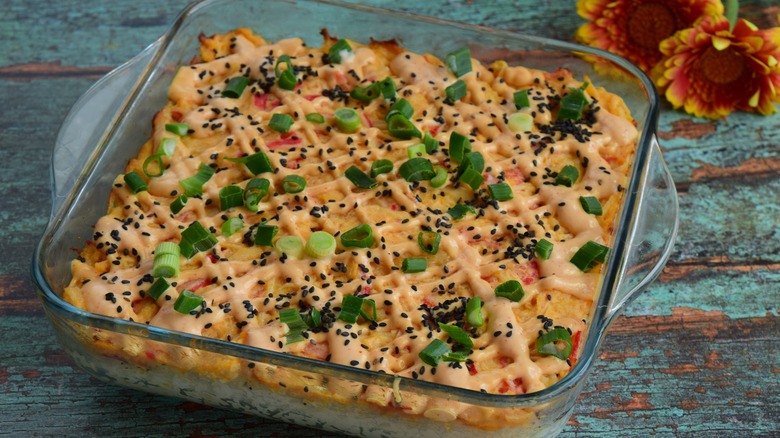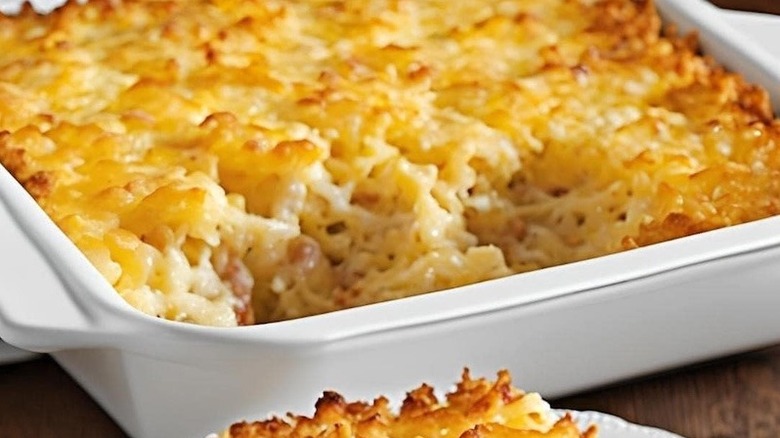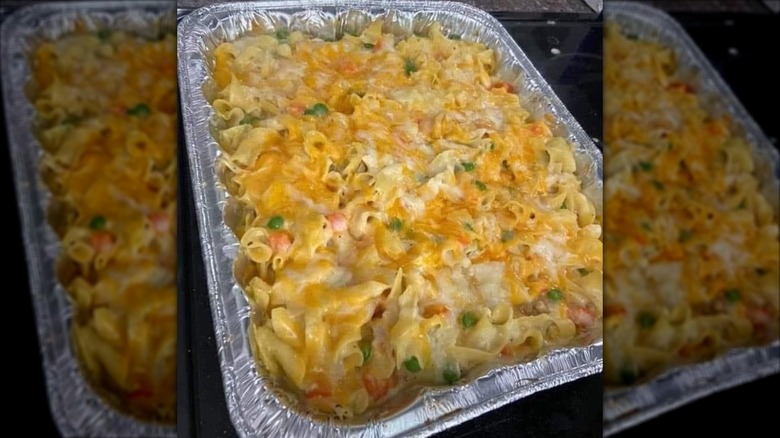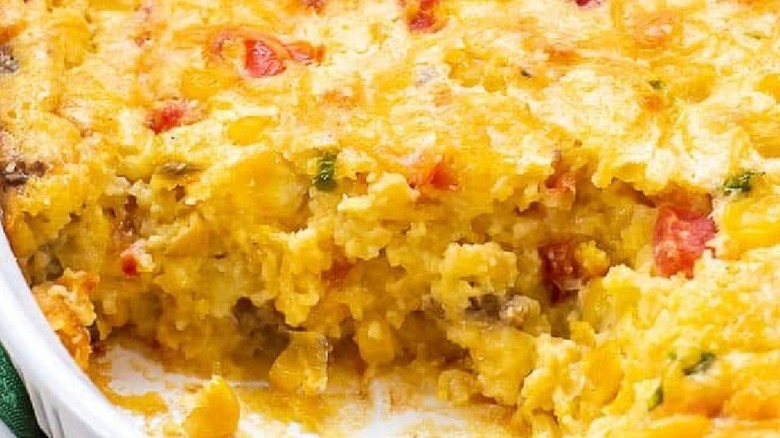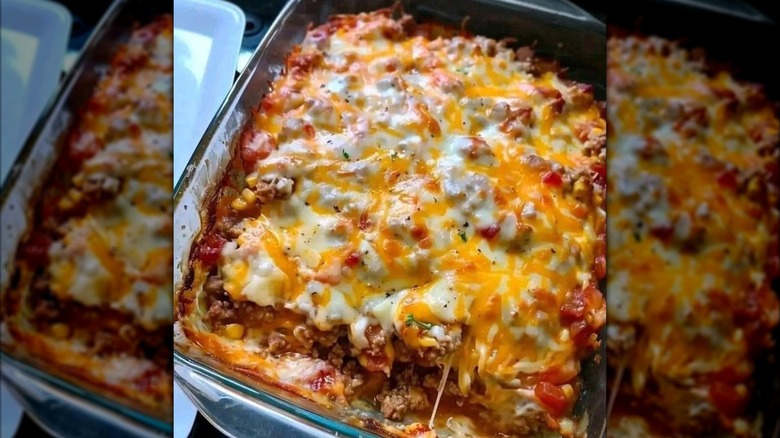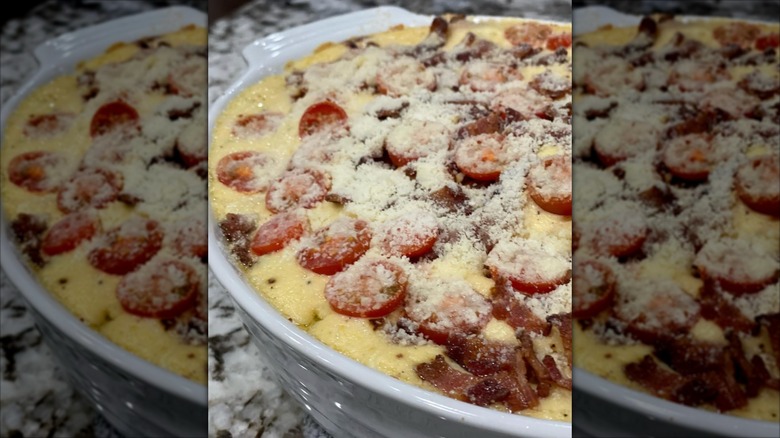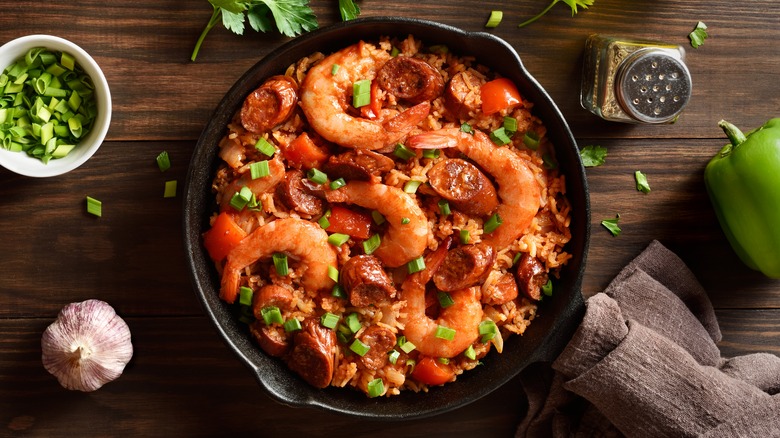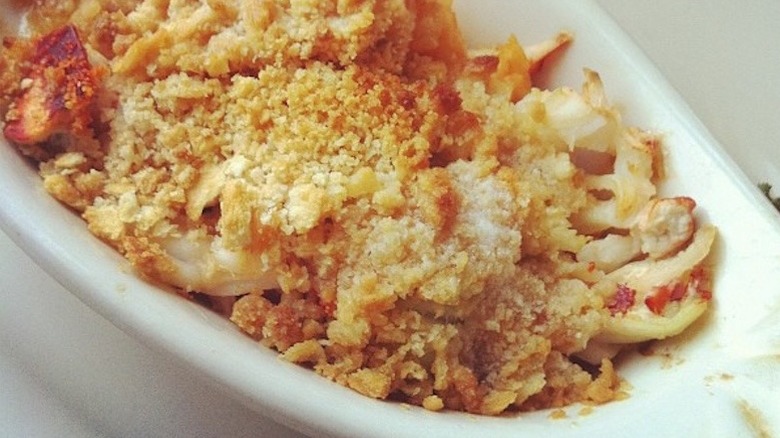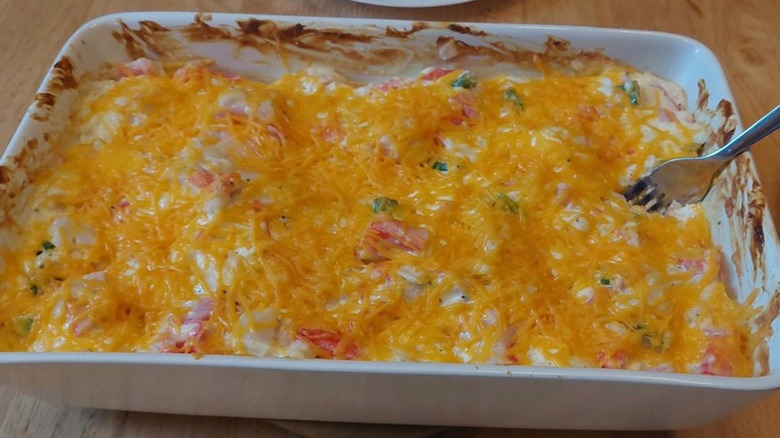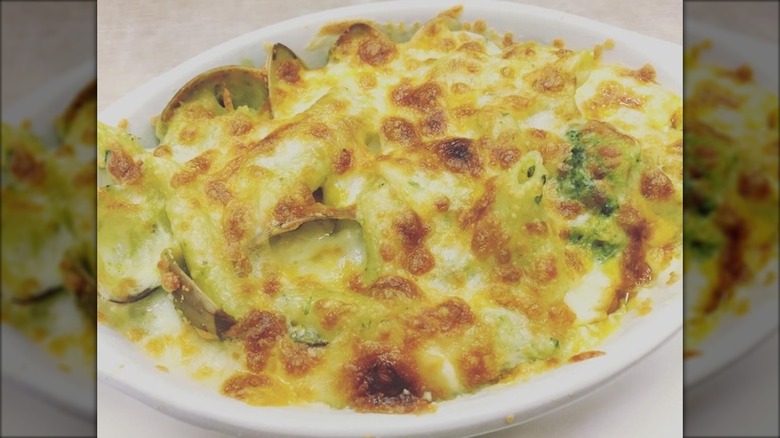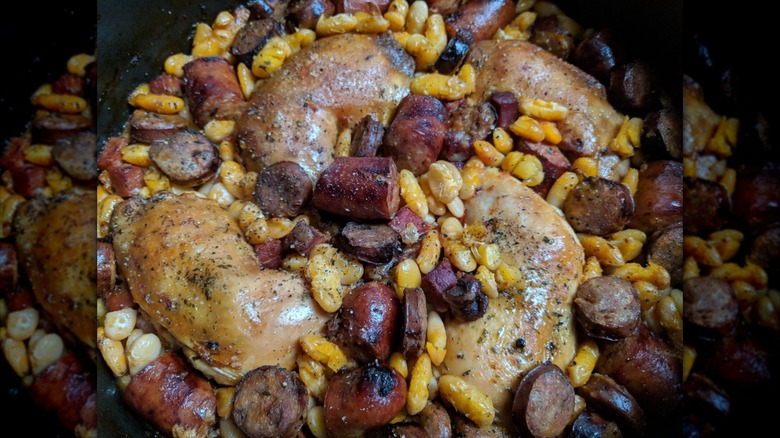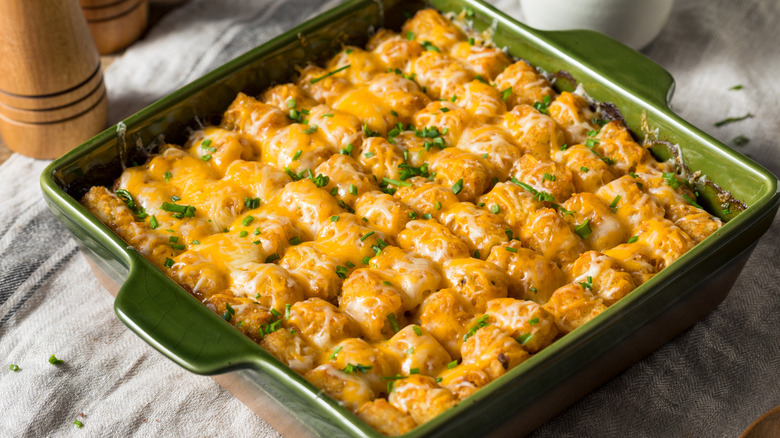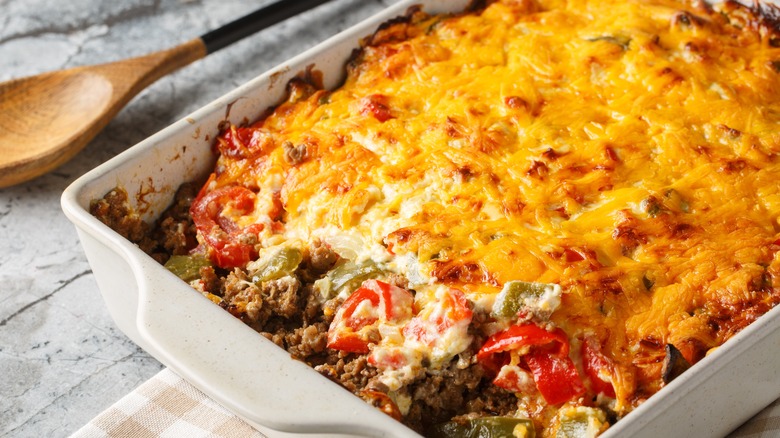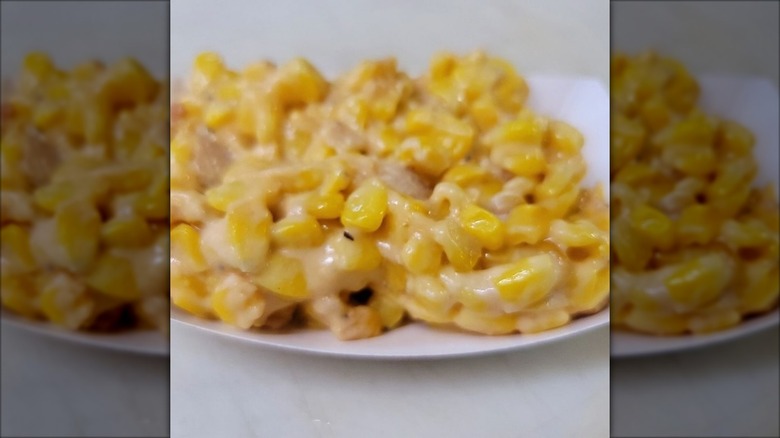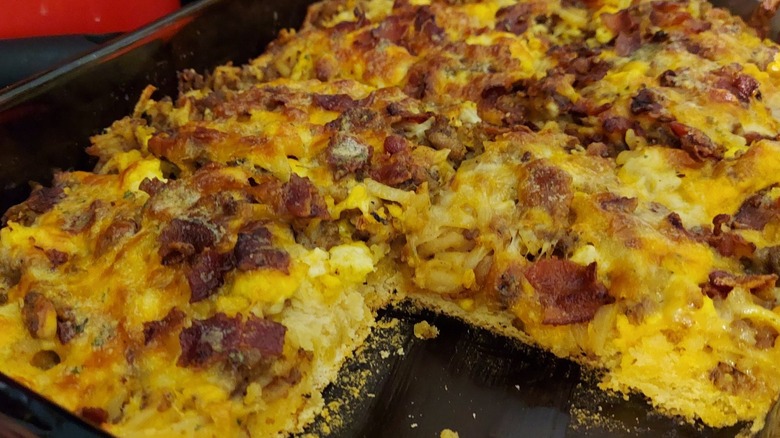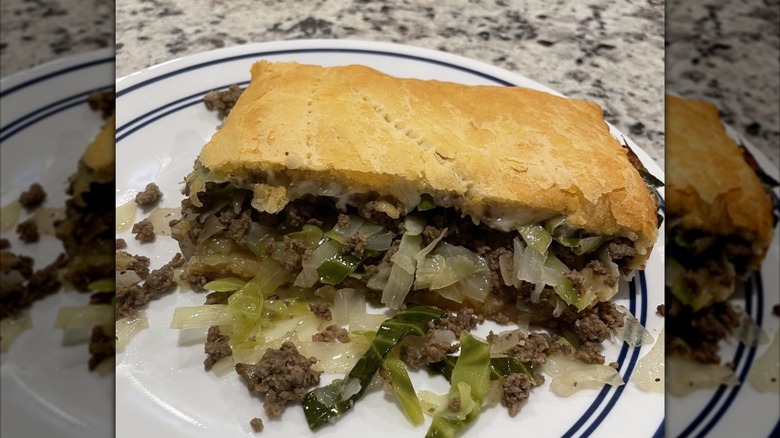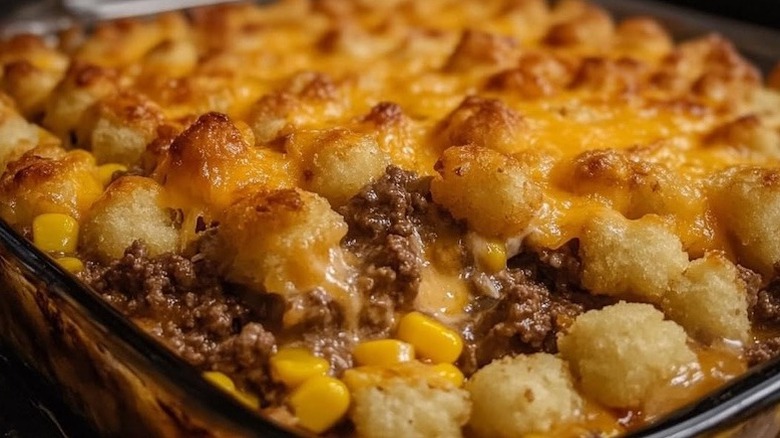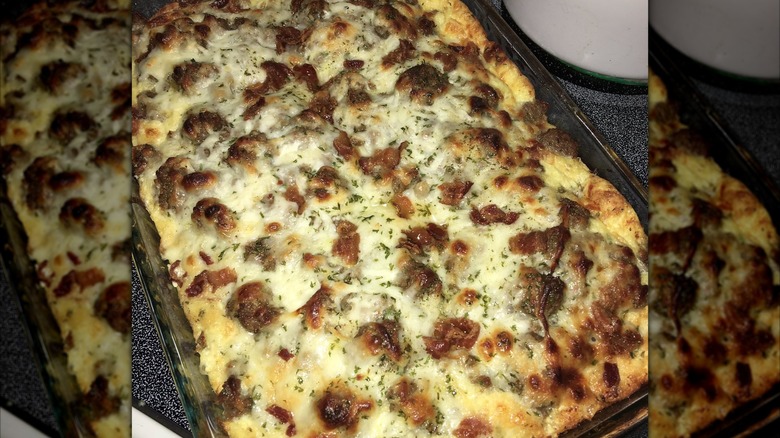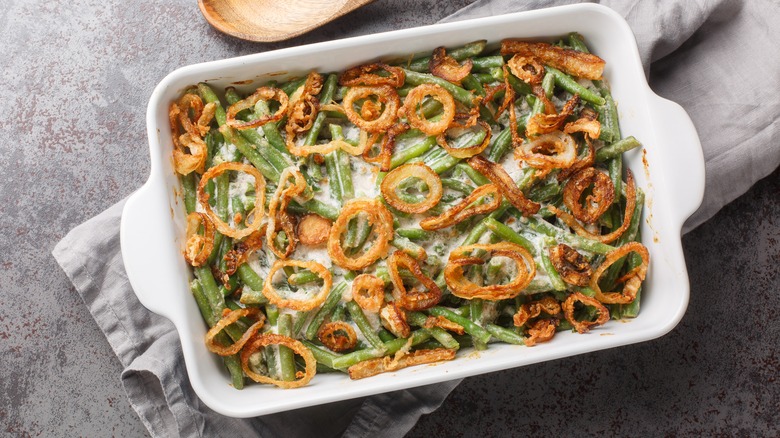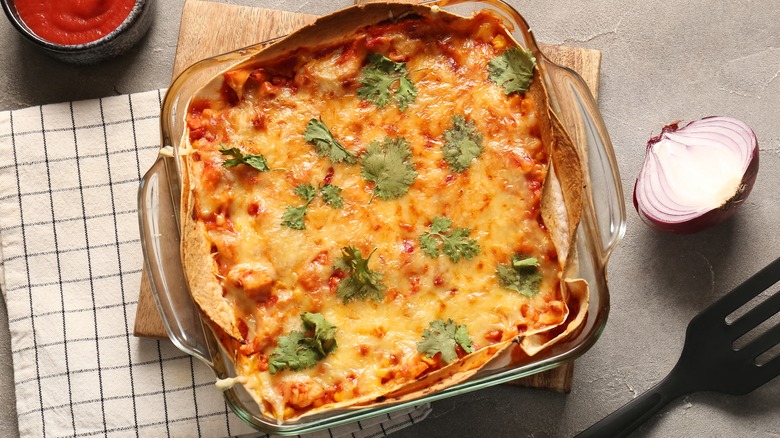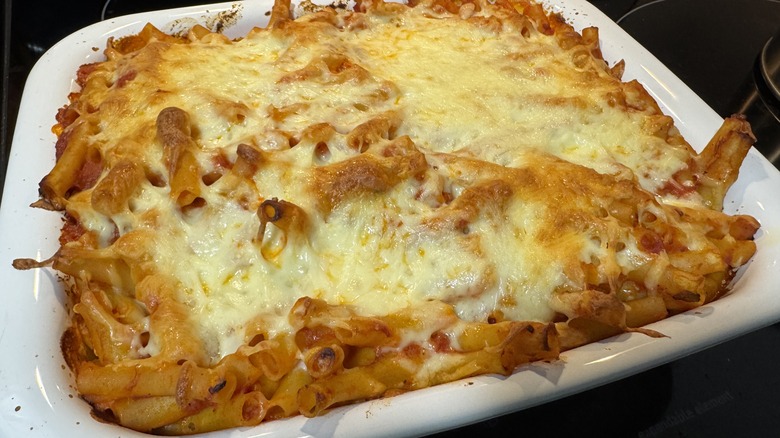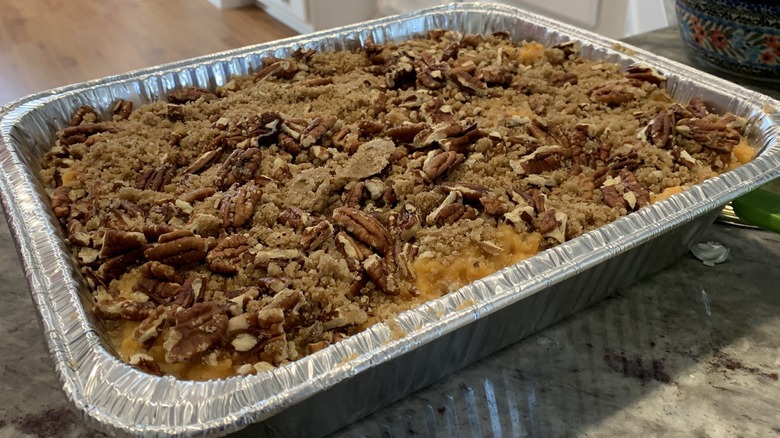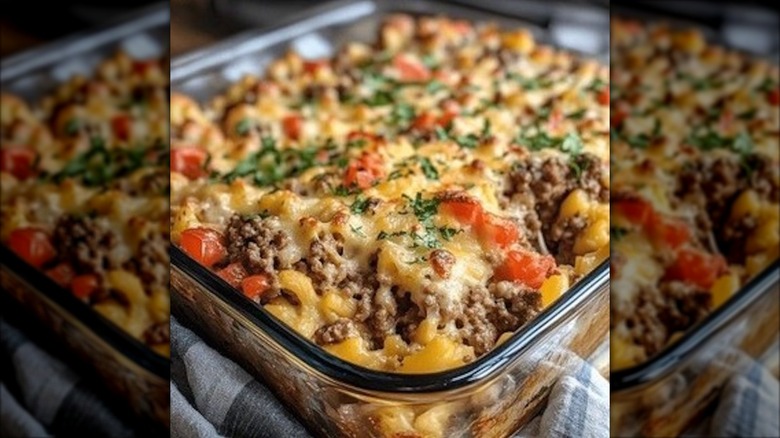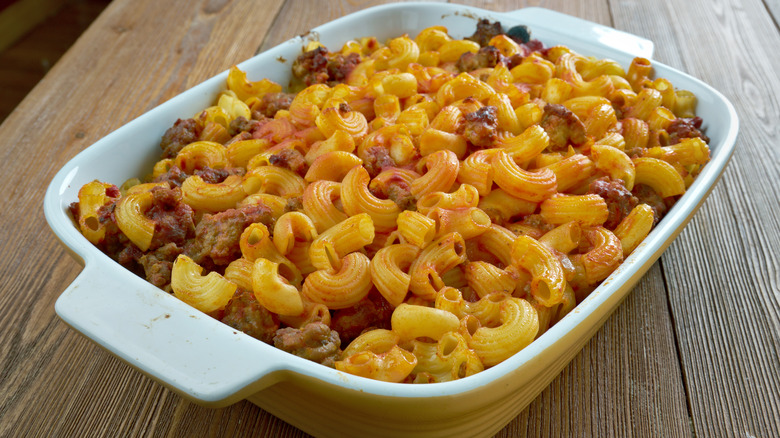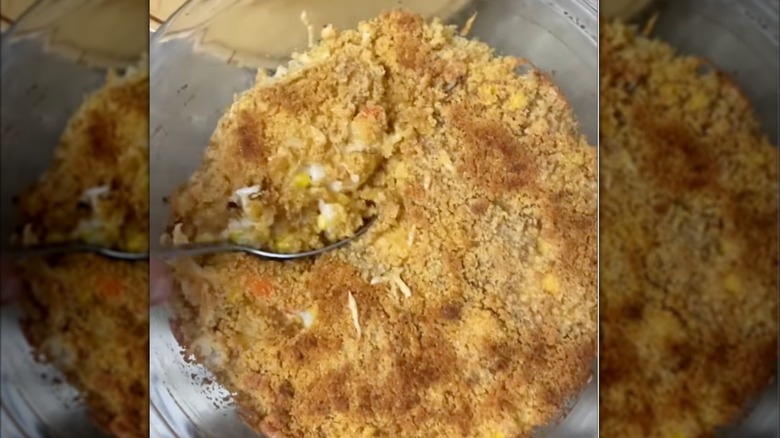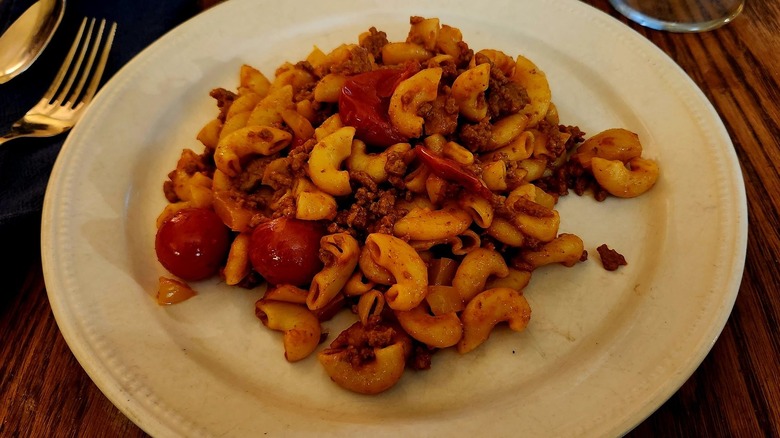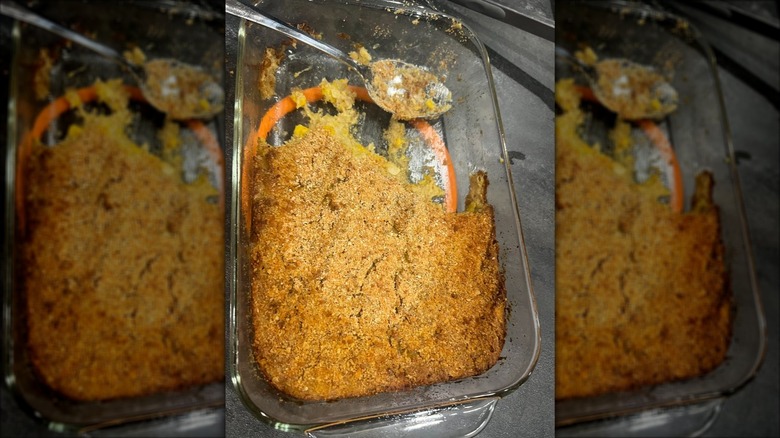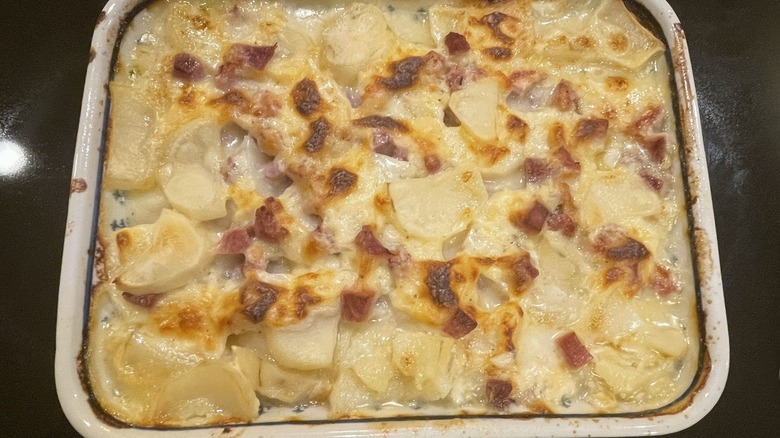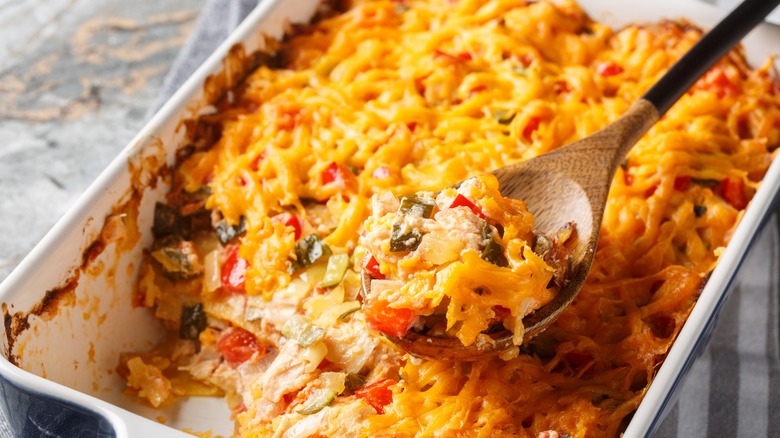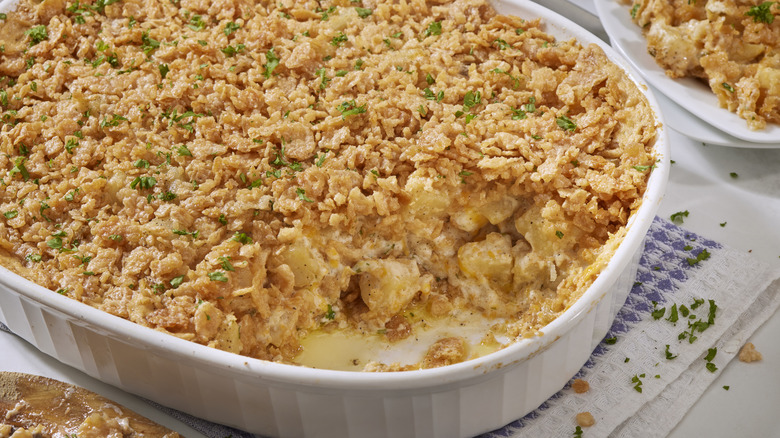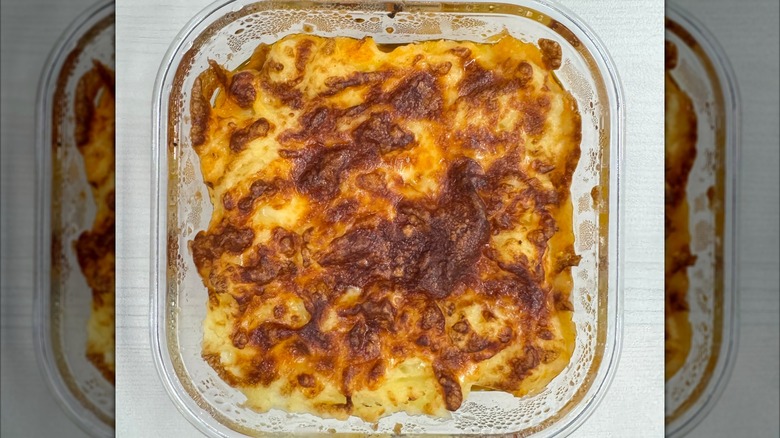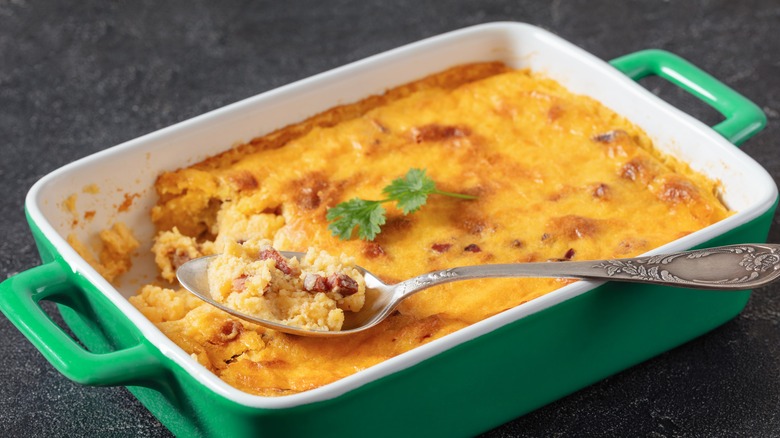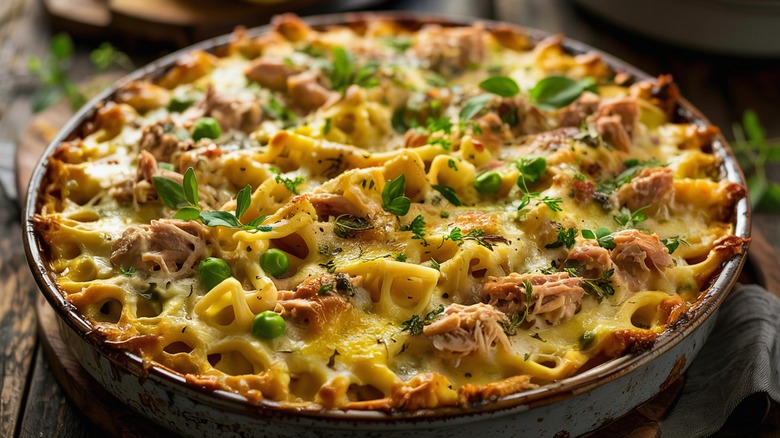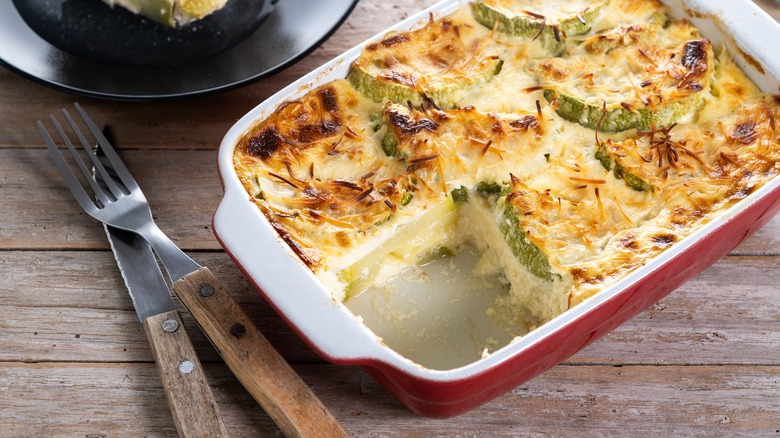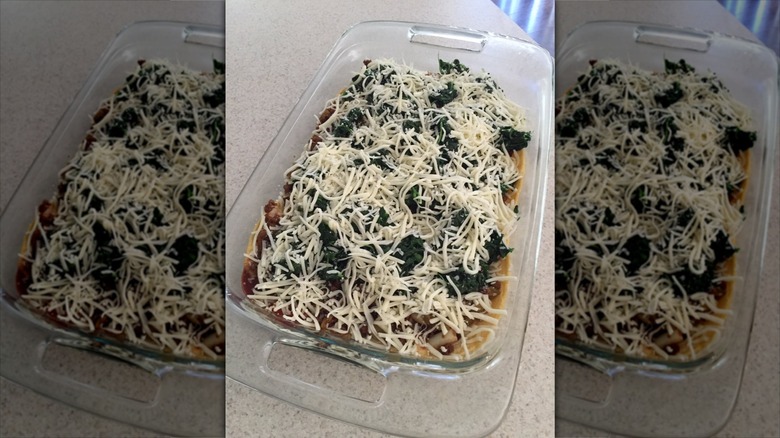Every State's Most Legendary Casserole
While the name of this broad category of culinary classics is a French word that refers to the cooking vessel and not what's in it, a casserole makes life easier, and it's perhaps the quintessential American food. Also called a bake or a hotdish, a casserole is an umbrella term for literally hundreds of different one-dish meals that can feed a family or any other large group of people, as well as side items so substantial and calorie-packed that they might as well be a main course.
Casseroles are, by their nature, very different from one another, but they also have a lot in common. They're all interchangeable with the idea of homemade or homestyle comfort food, steeped in traditions both familial and geographical. Also, they're usually all served piping hot and consist of a staple carbohydrate like noodles, potatoes, beans, or rice, often a protein source, and they generally involve some vegetables and cheese.
Every state in the United States can claim at least one old-fashioned and well-known hotdish as its own, some of which are vintage casseroles that have vanished somewhat in recent years. Such foods come about out of necessity and ingenuity, made from what naturally grows or is cultivated in each state, as well as what was celebrated in the area. With that in mind, here are some of the nation's most iconic casseroles, each strongly linked to a different state.
Alabama: squash Alabama
Alabama's hot climate is ideal for the cultivation of squash, including yellow squash. This has led to many squash-based casseroles in the state, such as squash Alabama. Served alongside ham, it's made with yellow squash in a sauce of eggs, mayonnaise, and cheese mixed with sautéed onions and bell peppers, and then topped with crumbled, buttered Ritz-style crackers.
Alaska: halibut Olympia
The waters surrounding Alaska have historically been abundant with fish, and locally caught halibut factors into the state's most famous casserole, halibut Olympia. First showing up in Alaskan cookbooks in the wake of World War II, the baked fish dish variously involves a white wine and sour cream-and-mayonnaise binder, a couple of pounds of halibut, onions, Parmesan cheese, and a topping of crushed buttery crackers.
Arizona: Arizona-Mexican casserole
A meld of Mexican, Indigenous, and European food histories, Arizona's cuisine pulls from many sources. Some casseroles in the state resemble enchilada bakes, including those bearing names like Arizona casserole or Arizona-Mexican casserole. The carb used most commonly in these casseroles is corn tortillas, which support a filling consisting of elements such as ground beef, onions, tomatoes, black olives, green chiles, enchilada sauce, or cheese, the latter of which is often the Southwestern-associated Monterey Jack.
Arkansas: rice casserole
Rice is a $1 billion industry in Arkansas, the state that grows the most of the crop. For that reason, it's unsurprising that the grain carbohydrate figures prominently in the state's home cooking traditions, starring in various rice casseroles. These may make use of beef or chicken but generally include easily found ingredients such as green bell peppers, pimentos, onions, cream of mushroom soup, and locally grown rice.
California: chicken tetrazzini
According to local lore — not to mention iconic chef and food writer James Beard — chicken tetrazzini was likely invented at San Francisco's Palace Hotel in the early 1900s, when chef Ernest Arbogast honored touring opera singer Luisa Tetrazzini with this pasta dish. It's typically made up of cooked spaghetti, chicken, mushrooms, garlic, and lots of Parmesan cheese that forms the basis for a cream sauce before it's all baked in a casserole dish.
Colorado: classic cheese strata
Casseroles aren't just for dinner, and when they're made for morning consumption with established breakfast ingredients, that dish is often called a strata. In Colorado, a ham, cheese, and broccoli strata is a classic combination. Slightly stale bread is left to soak in a casserole dish with eggs, milk, and the other ingredients overnight before it's popped into an oven until it's hot and eggy.
Connecticut: Lighthouse Inn potatoes
Designed to curtail food waste, Lighthouse Inn potatoes begins with a batch of cooked potatoes left uneaten from the previous day. Those spuds get reinvigorated by cream, butter, cheddar cheese, and bread crumbs. It's all put in an oven until the crumbs are brown, just like how chef Leon 'Wally' Walden did it for nearly 50 years at the Lighthouse Inn's kitchen in New London, Connecticut.
Delaware: crab imperial
Blue crab fishing plays a major role in the Delaware seafood industry. It's a plentiful source for local dishes, including a casserole called crab imperial. Recipes can differ, but will typically involve a mixture of Worcestershire sauce, eggs, and mayonnaise, combined with a generous amount of lump crab meat. The top gets sprinkled with a dusting of that signature mid-Atlantic seasoning, Old Bay, or paprika.
Florida: seafood casserole
Fresh fish and shellfish, like shrimp, are everywhere in the peninsula state of Florida, and they can be combined in lots of permutations into a seafood casserole. Seafood plays well in the creamy sauces used to hold the dish together, and stands up to texture, flavor, and color providers like water chestnuts, cheddar cheese, and pimentos. It all cooks together over a layer of white rice.
Georgia: Dillard House cabbage casserole
In the mountains of northeastern Georgia sits the historic Dillard House, which has served traditional Southern cooking since 1917. Its lunch and dinner menu both include a house-derived cabbage dish known around Georgia as Dillard House cabbage casserole. Unsurprisingly, this consists of cabbage and cheddar cheese baked in a creamy white sauce, topped with bread crumbs.
Hawaii: sushi bake
Cuisines from Japan and the mainland U.S. influence that of Hawaii, which is particularly evident in the popularity of sushi bake (also known as pan sushi or poke pan sushi). While "sushi" suggests the use of raw fish, sushi bake is a thoroughly cooked congregation of the ingredients often found in American sushi bars, built in a pan with rice, nori, furikake seasoning, crab, and spicy mayo drizzled on top.
Idaho: cheesy hash brown casserole
No state grows more potatoes than Idaho, and those tubers star in many signature state dishes, like cheesy hash brown casserole. A basic hot dish that can be served at breakfast or lunch, a common recipe requires little beyond hash browns (frozen or freshly cut) baked in a dish with cans of cream of chicken soup, cheese, milk, butter, and sour cream. Then it's all topped with more cheddar cheese and cornflakes. Delicious.
Illinois: noodle bake
Casserole culture is particularly endemic in the Midwest. Hotdish is expected at community gatherings and potlucks, and one such casserole category popular in Illinois is noodle bakes. Cooks start with a heaping pile of cooked egg noodles and add in dairy-based binders like sour cream and cottage cheese, as well as lightly flavoring veggies such as green onions.
Indiana: corn casserole
Indiana is a farming powerhouse, and around half of the space devoted to crops there is used to grow corn. Those kernels are versatile, and they can be sweet and savory, and Indiana corn casserole is both of those things. It's made with a lot of bacon, grease-cooked bell peppers, onions, celery, and sour cream, and more corn (fresh or frozen) than anything else.
Iowa: Pride of Iowa casserole
Historically, Iowa is one of the Midwestern states where one-pot dinners loom large, and one that's enjoyed there is a mid-20th-century concoction called the Pride of Iowa casserole. Iowa is one of the country's biggest pork sausage producers — not to mention another big producer of corn – and both commodities star in this casserole. Sausage, creamed corn, eggs, onion, and peppers get baked together under a top layer of ketchup.
Kansas: hamburger casserole
There's more than one way to make a tater tot casserole, like the Kansas favorite of hamburger casserole. According to any number of entrenched individual family or charity cookbook recipes, a hamburger casserole is a layered dish that utilizes cooked noodles and a sauce of sour cream and cream cheese. Then, before baking, the ground beef and cheddar cheese are added, as well as tater tots, if that's preferred.
Kentucky: Hot Brown casserole
The Brown Hotel in Louisville began serving the Hot Brown — an elegant turkey and bacon sandwich smothered in Mornay sauce, served open-face style — in the 1920s. All those ingredients make for a great casserole, too, and it's one that can be found around Kentucky. Along with chopped tomatoes, cubed white bread, and Parmesan cheese, it's a deconstruction and reconstruction of an iconic sandwich.
Louisiana: jambalaya
A foundational dish in the robust food culture that developed in and around New Orleans, jambalaya is a spicy, meaty rice dish prepared in a skillet, or sometimes oven-baked like a casserole. Countless versions exist across Creole and Cajun cuisines — and the use of tomatoes may vary — but a jambalaya will almost certainly employ some combination of shrimp, andouille sausage, chicken, onions, bell peppers, celery, rice, and a powerful spice blend.
Maine: lobster casserole
The coastal waters around Maine have been rich with lobster for hundreds of years. Caught, canned, and shipped all over as a luxury good, lobster is almost mundane in Maine, where it's just an ingredient in regular-day food like Maine lobster casserole. Pan-sautéed mushrooms and chunks of the shellfish combine with a mustard-flavored roux, butter, milk, and lobster stock, with crushed oyster crackers providing the carbohydrate layer.
Maryland: crab casserole
The blue crab is the official state crustacean of Maryland, and the shellfish informs a lot of the local flavors. It's the main thing in a baked crab casserole prepared around the mostly coastal-adjacent state and often found in Chinese-American restaurants. The dip-like dish makes use of the likes of cream, Swiss, and cheddar cheeses, Old Bay and mustard powders, and mayonnaise and sour cream, often served with crackers.
Massachusetts: clam casserole
There are many different varieties of clams to be found in coastal Massachusetts, where they're often eaten fresh in the summer or canned, in soups or chowder, and in warm casseroles in the winter. Clams can factor into mixed seafood casseroles alongside the likes of crustaceans and whitefish, or serve as the star of a simple dish made with just margarine, milk, eggs, and saltines, and perhaps onions and potatoes.
Michigan: Michigan cassoulet
The French cassoulet is a precursor to the more American style of casserole. French villages were established in what's now Michigan in the late 17th century, providing the pathway for French food to help shape the cuisine of the state, as is evident in dishes such as the Michigan cassoulet. Baked in a casserole dish, this is an amalgam of navy beans, chicken pieces, bacon, sausages, and duck fat.
Minnesota: tater tot hotdish
Hotdish is the Minnesota term for all-in-one meals cooked in a casserole dish and consisting of a starch, meat, vegetables, and a soup binder. Potatoes, noodles, or rice might fulfill the starch role, along with chicken or ground beef and a creamy canned soup, but the most signature Minnesota twist on casserole (or hotdish) is topping the whole thing with frozen tater tots.
Mississippi: John Wayne casserole
In 1979, a young Cara Connery set out to raise money for cancer charities by publishing a fundraising cookbook featuring contributions from celebrities. Not long before he passed away, John Wayne sent Connery a recipe for an egg and cheese casserole. The University of Mississippi Medical Center cafeteria in Jackson adapted the breakfast dish, removing the eggs and beefing it up (literally) with ground beef, tomatoes, onions, peppers, and taco seasoning to create a simple yet hearty option for any time of day.
Missouri: Kansas City cheesy corn
A city or a state's barbecue culture is more than just a meat preference and a special sauce — it also includes some common side dishes. Many barbecue joints in Kansas City, Missouri, serve their own version of Kansas City cheesy corn. Made famous by Fiorella's Jack Stack, it's a smooth, creamy dish that squeezes into casserole territory by combining corn, ham bits, and a rich sauce in one dish. The result is indulgent, flavorful, and somewhat similar to homemade macaroni and cheese.
Montana: sausage biscuit casserole
Montana is home to several Amish communities, and its casseroles have entered into the state's food vernacular. This includes the grand, crowd-pleasing (and crowd-filling) sausage biscuit casserole. Bisquick (or something similar) goes at the bottom of the casserole dish, and then come the hash browns, peppers and onions, shredded cheese, and both sausage and bacon.
Nebraska: runza casserole
A runza is a European pocket sandwich filled with beef and cabbage, and they've been sold by the Runza chain throughout Nebraska since 1949. The sandwich is so well-known in the state that a deconstruction in the form of a casserole is a commonly served dish. Ground meat, onions, cabbage, and cheese go between layers of flaky premade dough.
Nevada: cowboy casserole
A recipe for the casserole best linked to Nevada was published by Nevada's statewide association of dairy farmers, taking inspiration from the area's Old West history and classic Midwestern casseroles. A top layer of frozen tater tots and cheddar cheese covers a medley of cumin-seasoned corn, ground beef, black beans, and crumbled bacon, all held together with cream cheese, sour cream, and milk.
New Hampshire: che casserole
According to local lore, the first time someone made what would today be considered a casserole was in Berlin, New Hampshire, in 1866. The recently emigrated French-Canadian Elmire Jolicoeur purportedly created the che casserole, which is said to be an egg casserole. Egg casseroles are still commonplace today, with the eggs often combined with the likes of cheese and sausage in a deep pan and baked in an oven.
New Jersey: green bean casserole
One of the most popular Thanksgiving side dishes across the United States, green bean casserole enjoys a special place on the table in New Jersey. Dorcas Reilly, a home economics consultant hired by Campbell's Soup, invented the casserole in Camden in 1955, combining cream of mushroom soup with French's crispy fried onions, canned green beans, and milk.
New Mexico: red chile enchilada casserole
The food of New Mexico pulls from Mexican, Spanish, and indigenous influences, and chile is one of the state's official vegetables. Red chile enchilada casserole is a representative meal, then, composed of a pan of enchiladas made with layered corn tortillas, seasoned chicken or beef, beans, cheese, and locally sourced red chile sauce.
New York: baked ziti
Baked ziti is a popular dish that has its roots in Southern Italy and was further developed by Italian immigrants who settled around the New York City area. The original is made up of fresh tomato sauce, garlic, basil, and small, tubular ziti pasta. The sauce also contains meat, generally in the form of ground beef and Italian sausage, topped with lots of cheese.
North Carolina: sweet potato casserole
A huge percentage of the nation's sweet potatoes come from North Carolina, where the residents know many creative ways to use the plentiful crop. Sweet potato casseroles are a sweet and savory solution, mixing cooked sweet potatoes with sugar, eggs, butter, and autumnal spices beneath a crunchy pecan topping.
North Dakota: red hotdish
North Dakota is one of the places where dinner and shareable casseroles are routine and known as a hotdish. Red hotdish is one go-to example in North Dakota that combines seasoned and garlic-spiced ground beef with noodles in a tomato-based or spaghetti sauce, bulked up with cream of mushroom soup.
Ohio: Johnny Marzetti
Chili macaroni — whether it's canned by Chef Boyardee or presented in a kit by Hamburger Helper – was inspired by an Ohio creation called Johnny Marzetti. Columbus restaurant owner Teresa Marzetti named one of her dishes after her brother-in-law, Johnny: a casserole made with elbow macaroni and ground beef cooked in a rich tomato sauce and covered with cheese.
Oklahoma: tamale pie
The influence of Tex-Mex cuisine extends north into Oklahoma, which is also a significant producer of beef. Many households in the state have their own recipe for tamale pie, a casserole that approximates the handheld Mexican meat sandwich. Starting with a base of cornmeal or masa to imitate the tamale's outer starchy coating, the casserole also makes use of ground beef, tomatoes, onions, and cheddar cheese.
Oregon: Dungeness crab and corn
The Dungeness crab is a large and plentiful crustacean in the Pacific Ocean. Its flesh is sweet and meaty, and it's vital to Oregon's food scene, frequently paired with sweet corn, especially in a recurrent casserole. Sort of like a spicy crab corn pudding, that dish uses canned corn, corn muffin mix, preserved red peppers, and all the meat from a single Dungeness crab.
Pennsylvania: Amish yumasetta
Developed in the Pennsylvania Dutch community, this modernized version of a homestyle dish incorporates both fresh and processed ingredients. Hamburger meat and onions are cooked together and combined with egg noodles, milky cream of chicken soup, and tangy tomato soup to make this potluck staple that's eye-catching for its bright red sauce and the use of bright orange American cheese.
Rhode Island: American chop suey
A strong deviation from the chop suey sold in Chinese-American restaurants, American chop suey has its roots in New England, and proved particularly popular in Rhode Island. Vegetables like onions and cabbage fell away in favor of a chunky tomato sauce, and the rice was replaced with pasta. With beef and a cheese topping added, American chop suey is very similar to canned beefaroni, or Ohio's Johnny Marzetti.
South Carolina: Southern squash casserole
Yellow squash, a kind of summer squash, grows all over South Carolina through the spring and summer, and the absorbent veggie is the center of many casseroles. Whether squash casserole is found at potlucks, on cafeteria menus, or on the family dinner table, it's often a straightforward build of summer squash, butter, onions, eggs, sharp cheddar cheese, and copious amounts of crumbled saltine crackers.
South Dakota: funeral potatoes
While there are several regional casseroles known as funeral potatoes – whose name is inspired by the fact that the dish was often served at post-service church receptions — South Dakota's version of the hearty, cheesy, and starchy casserole is more likely than others to contain extra protein. This is a ham and scalloped potatoes dish prepared in the style of a casserole.
Tennessee: Tennessee onions
The sweet and not overly caustic Vidalia onions have been cultivated in the neighboring state of Georgia since the 1930s, inspiring a casserole still closely connected to Tennessee. Along with Vidalia onions, Tennessee onions require the use of multiple kinds of cheese, as well as butter and a variety of savory spices. Seasoned onions and all that cheese bake up together to a crispy, chewy, golden brown delight.
Texas: King Ranch chicken casserole
The King Ranch is Texas's largest cattle ranch, and the namesake for a Texan chicken casserole. The recipe took first place in a 1972 Texas newspaper recipe contest and seemingly takes its inspiration from chilaquiles, a historically Mexican dish. Corn tortillas or chips are layered with tomatoes, onions, peppers, cheese, chiles, and diced chicken, and it's all held together with canned cream of mushroom and chicken soup and chicken broth.
Utah: funeral potatoes
In Utah, it's thought that over 40% of the population is affiliated with The Church of Jesus Christ of Latter-day Saints, historically known as the Mormon Church. Funeral potatoes are considered so ubiquitous at community, church, and family gatherings that they're also known as Mormon funeral potatoes. Checking all the comfort food boxes, funeral potatoes are made from frozen hash browns, creamy soups, and plenty of butter, sour cream, and cheese. As it bakes, a layer of cornflakes on top provides some crunchy textural variety.
Vermont: baked macaroni and cheese
Vermont is famous for its cheese, particularly the strong, sharp, and stinging Vermont cheddar, such as that produced by Cabot Creamery. Households and many restaurants use the locally produced dairy on many dishes — particularly their own versions of baked macaroni and cheese, a starchy, savory, and salty casserole that's indulgently creamy on the inside and perfectly crispy on the outside.
Virginia: grits casserole
Grits, a porridge made from ground corn, are served in a number of ways throughout the South. Some are thick or soupy, and some form the basis of baked, flavored casseroles, particularly in Virginia. Packaged grits are cooked and then set into an oven-cooked dish with a variety of cheeses — such as Gouda, Gruyère, or cheddar — and maybe sausage or bacon, then served at breakfast, brunch, dinner, or whenever the casserole craving hits.
Washington: tuna noodle casserole
There are probably just as many different recipes for tuna noodle casserole as there are families who ate this regularly on weekends in the latter half of the 20th century. Cooked egg noodles, binding cream soups (such as cream of mushroom or cream of celery), and a crispy topping help support inexpensive canned tuna as the protein. Washington state is a major producer and consumer of fish, and the first recipe was published in the Pacific Northwest-focused Sunset Magazine in 1930.
West Virginia: squash and zucchini casserole
Several varieties of squash and zucchini thrive in Appalachia, and one of the ways that West Virginians use up those prolific and squishy vegetables is with casseroles. Large amounts of cut and sliced squash and zucchini are combined with standard casserole elements like Ritz-style crackers, butter, milk, eggs, cheese, and onions.
Wisconsin: Wisconsin casserole
Wisconsin is a prominent potato producer and is famously a major maker of cheeses and sausage. All of those ingredients are important to a local casserole format. A Wisconsin casserole will include sliced potatoes, chopped onions and peppers, kielbasa sausage or smoked sausage, and plenty of cheddar cheese, all heated underneath a crispy layer of potato chips or crackers.
Wyoming: Wyoming casserole
As a state known for its cattle ranches and cattle drives, beef is a popular ingredient in Wyoming casseroles. One representative dish takes the protein, taco seasoning, and Monterey Jack cheese and combines them with ham, spinach, and sour cream before it all goes into tortillas for a warm and filling enchilada-style bake.

